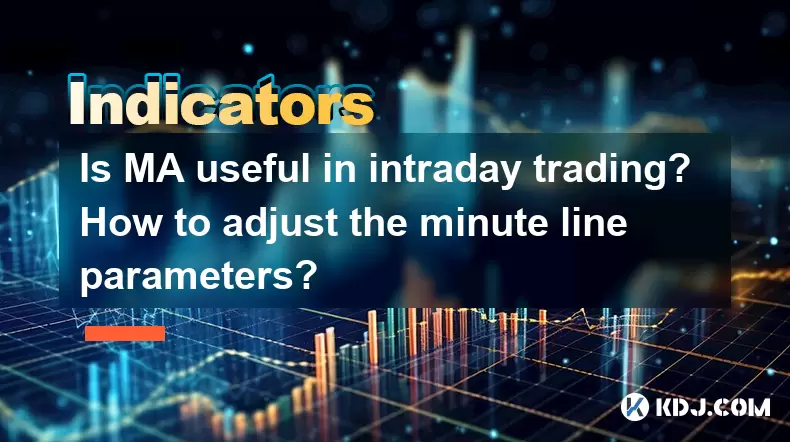-
 bitcoin
bitcoin $122090.672462 USD
1.59% -
 ethereum
ethereum $4493.758974 USD
0.56% -
 xrp
xrp $3.033145 USD
0.65% -
 tether
tether $1.000629 USD
0.00% -
 bnb
bnb $1169.854250 USD
7.07% -
 solana
solana $230.954786 USD
-0.19% -
 usd-coin
usd-coin $0.999785 USD
0.00% -
 dogecoin
dogecoin $0.256108 USD
-1.12% -
 tron
tron $0.342333 USD
-0.12% -
 cardano
cardano $0.859632 USD
-0.10% -
 hyperliquid
hyperliquid $48.932146 USD
-2.25% -
 chainlink
chainlink $22.345466 USD
-1.29% -
 ethena-usde
ethena-usde $1.000217 USD
-0.03% -
 avalanche
avalanche $31.203456 USD
1.93% -
 sui
sui $3.579145 USD
1.05%
Is MA useful in intraday trading? How to adjust the minute line parameters?
MA is crucial in intraday trading for identifying trends; adjust minute line parameters like time frame, MA type, and period length for optimal results.
May 21, 2025 at 05:21 pm

Is MA Useful in Intraday Trading? How to Adjust the Minute Line Parameters?
The Moving Average (MA) is a popular technical indicator used by traders to identify trends and potential entry and exit points in the market. In intraday trading, where the focus is on making trades within a single trading day, the utility of MA can be significant. This article will explore the effectiveness of MA in intraday trading and provide a detailed guide on adjusting minute line parameters to optimize trading strategies.
The Role of MA in Intraday Trading
Intraday trading involves buying and selling assets within the same trading day, aiming to capitalize on short-term price movements. The Moving Average (MA) plays a crucial role in this context by smoothing out price data to create a single flowing line, making it easier to identify the direction of the trend.
In intraday trading, traders often use shorter-term MAs, such as the 5-minute, 10-minute, or 15-minute MAs, to capture quick price movements. These shorter time frames can help traders identify entry and exit points more accurately than longer-term MAs, which are more suited for swing or position trading.
Types of MAs and Their Applications
There are several types of Moving Averages, each with its own method of calculation and application in intraday trading. The most common types include the Simple Moving Average (SMA), Exponential Moving Average (EMA), and Weighted Moving Average (WMA).
Simple Moving Average (SMA): This is calculated by taking the arithmetic mean of a given set of prices over a specific number of periods. It is straightforward but can be slow to respond to recent price changes.
Exponential Moving Average (EMA): This type of MA places more weight on recent prices, making it more responsive to new information. This characteristic makes the EMA particularly useful for intraday traders looking to react quickly to market movements.
Weighted Moving Average (WMA): Similar to the EMA, the WMA assigns more weight to recent prices but uses a linear weighting scheme. It can be beneficial for traders who want to emphasize the most recent data but prefer a different weighting approach than the EMA.
Adjusting Minute Line Parameters for Intraday Trading
Adjusting the parameters of minute lines is crucial for optimizing the use of MAs in intraday trading. Here’s a detailed guide on how to adjust these parameters effectively:
Choosing the Right Time Frame: The first step in adjusting minute line parameters is selecting the appropriate time frame. For intraday trading, common time frames include 1-minute, 5-minute, 10-minute, and 15-minute charts. The choice depends on the trader's strategy and the asset's volatility.
Selecting the MA Type: Decide whether to use SMA, EMA, or WMA based on the desired responsiveness to price changes. For intraday trading, EMA is often preferred due to its sensitivity to recent price movements.
Setting the Period Length: The period length of the MA should be adjusted according to the chosen time frame. For instance, a 5-minute chart might use a 20-period MA, which equates to 100 minutes of data. Experiment with different period lengths to find the optimal setting for your trading strategy.
Using Multiple MAs: Many intraday traders use multiple MAs to generate more reliable signals. For example, a trader might use a short-term MA (e.g., 5-period EMA) and a longer-term MA (e.g., 20-period EMA) to identify crossovers that signal potential entry and exit points.
Adjusting Sensitivity: The sensitivity of the MA can be fine-tuned by altering the period length. A shorter period length makes the MA more sensitive to price changes, while a longer period length results in a smoother, less responsive line.
Practical Application of MAs in Intraday Trading
To illustrate how MAs can be applied in intraday trading, let's consider a practical example using a 5-minute chart and EMA.
Setting Up the Chart: Open your trading platform and select a 5-minute chart for the asset you wish to trade.
Adding MAs: Add two EMAs to the chart:
- Short-term EMA: Set the period to 5.
- Long-term EMA: Set the period to 20.
Identifying Entry and Exit Points: Look for crossovers between the two EMAs. When the short-term EMA crosses above the long-term EMA, it may signal a bullish trend and a potential entry point. Conversely, when the short-term EMA crosses below the long-term EMA, it may indicate a bearish trend and a potential exit point.
Monitoring and Adjusting: Continuously monitor the chart and adjust the MA parameters as needed based on the asset's volatility and market conditions. If the market becomes more volatile, you might shorten the period lengths to increase sensitivity. In less volatile conditions, longer period lengths may be more effective.
Combining MAs with Other Indicators
While MAs are powerful tools on their own, combining them with other technical indicators can enhance their effectiveness in intraday trading. Some popular combinations include:
MA and RSI: The Relative Strength Index (RSI) can help confirm MA signals. For instance, if the short-term EMA crosses above the long-term EMA and the RSI is above 50, it may strengthen the bullish signal.
MA and MACD: The Moving Average Convergence Divergence (MACD) can provide additional confirmation of trend direction. A bullish crossover in the MACD can reinforce a bullish MA crossover, and vice versa.
MA and Bollinger Bands: Bollinger Bands can help identify overbought and oversold conditions. When the price touches the upper Bollinger Band and the short-term EMA is above the long-term EMA, it may indicate a strong bullish trend. Conversely, when the price touches the lower Bollinger Band and the short-term EMA is below the long-term EMA, it may signal a strong bearish trend.
FAQs
Q1: Can MA be used effectively in volatile markets?A1: Yes, MAs can be used effectively in volatile markets by adjusting the period length to shorter time frames, such as a 1-minute or 5-minute chart. This increases the MA's sensitivity to price changes, allowing traders to react more quickly to market movements.
Q2: How do I know if my MA settings are optimal for intraday trading?A2: The optimal MA settings for intraday trading can be determined through backtesting and continuous monitoring. Experiment with different time frames and period lengths to find the settings that generate the most reliable signals for your trading strategy.
Q3: What are the risks of relying solely on MAs for intraday trading?A3: Relying solely on MAs for intraday trading can lead to false signals and missed opportunities. MAs are lagging indicators, meaning they are based on past price data. Combining MAs with other technical indicators and fundamental analysis can help mitigate these risks and improve trading decisions.
Q4: How often should I adjust my MA parameters?A4: MA parameters should be adjusted as needed based on changes in market conditions and asset volatility. Regularly review and backtest your settings to ensure they remain effective. Some traders adjust their parameters daily, while others may do so weekly or monthly depending on their strategy and market dynamics.
Disclaimer:info@kdj.com
The information provided is not trading advice. kdj.com does not assume any responsibility for any investments made based on the information provided in this article. Cryptocurrencies are highly volatile and it is highly recommended that you invest with caution after thorough research!
If you believe that the content used on this website infringes your copyright, please contact us immediately (info@kdj.com) and we will delete it promptly.
- BlockDAG, DOGE, HYPE Sponsorship: Crypto Trends Shaping 2025
- 2025-10-01 00:25:13
- Deutsche Börse and Circle: A StableCoin Adoption Powerhouse in Europe
- 2025-10-01 00:25:13
- BlockDAG's Presale Buzz: Is It the Crypto to Watch in October 2025?
- 2025-10-01 00:30:13
- Bitcoin, Crypto, and IQ: When Genius Meets Digital Gold?
- 2025-10-01 00:30:13
- Stablecoins, American Innovation, and Wallet Tokens: The Next Frontier
- 2025-10-01 00:35:12
- NBU, Coins, and Crypto in Ukraine: A New Yorker's Take
- 2025-10-01 00:45:14
Related knowledge

What is a tower bottom candlestick pattern? Does it have a high success rate?
Sep 22,2025 at 07:18am
Tower Bottom Candlestick Pattern Explained1. The tower bottom candlestick pattern is a reversal formation that typically appears at the end of a downt...

What is a black hole pattern in the MACD indicator? Is it a cause for concern?
Sep 21,2025 at 06:54pm
Bitcoin's Role in Decentralized Finance1. Bitcoin remains the cornerstone of decentralized finance, serving as a benchmark for value and security acro...

How can I use the psychological line (PSY) to determine market sentiment?
Sep 17,2025 at 02:19pm
Understanding the Psychological Line (PSY) in Cryptocurrency TradingThe Psychological Line, commonly referred to as PSY, is a momentum oscillator used...

How can I determine if a double top pattern has officially formed?
Sep 21,2025 at 03:18am
Understanding the Structure of a Double Top Pattern1. A double top pattern consists of two distinct peaks that reach approximately the same price leve...

What is the Golden Valley pattern on the moving average? Is it better than the Silver Valley pattern?
Sep 21,2025 at 02:54pm
Understanding the Golden Valley Pattern in Moving Averages1. The Golden Valley pattern is a technical formation observed in cryptocurrency price chart...

What does a death cross of the RSI in the strong zone (above 50) mean?
Sep 17,2025 at 10:54pm
Understanding the Death Cross in RSI Context1. The term 'death cross' is traditionally associated with moving averages, where a short-term average cro...

What is a tower bottom candlestick pattern? Does it have a high success rate?
Sep 22,2025 at 07:18am
Tower Bottom Candlestick Pattern Explained1. The tower bottom candlestick pattern is a reversal formation that typically appears at the end of a downt...

What is a black hole pattern in the MACD indicator? Is it a cause for concern?
Sep 21,2025 at 06:54pm
Bitcoin's Role in Decentralized Finance1. Bitcoin remains the cornerstone of decentralized finance, serving as a benchmark for value and security acro...

How can I use the psychological line (PSY) to determine market sentiment?
Sep 17,2025 at 02:19pm
Understanding the Psychological Line (PSY) in Cryptocurrency TradingThe Psychological Line, commonly referred to as PSY, is a momentum oscillator used...

How can I determine if a double top pattern has officially formed?
Sep 21,2025 at 03:18am
Understanding the Structure of a Double Top Pattern1. A double top pattern consists of two distinct peaks that reach approximately the same price leve...

What is the Golden Valley pattern on the moving average? Is it better than the Silver Valley pattern?
Sep 21,2025 at 02:54pm
Understanding the Golden Valley Pattern in Moving Averages1. The Golden Valley pattern is a technical formation observed in cryptocurrency price chart...

What does a death cross of the RSI in the strong zone (above 50) mean?
Sep 17,2025 at 10:54pm
Understanding the Death Cross in RSI Context1. The term 'death cross' is traditionally associated with moving averages, where a short-term average cro...
See all articles










































































